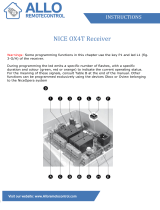
EN
English - 7
03. On the NEW transmitter, press the same key as in step
01 once and then release it.
4.2 –Total deletion of the receiver memory
WARNING! – When you do this, the software lock function is
also deleted and the "Timer" is automatically set to 3 sec.
01. Press and keep key P1 (fig. 1) on the receiver pressed:
after 3 sec. LED L1 is turned off;
02. When LED L1 starts flashing again, on the 3rd flash,
release key P1 and wait approximately 3 sec.;
03. As soon as LED L1 is turned back on, press key P1 and
release it as soon as the LED is turned off.
Depending on the type of memory fitted on the receiver, the
process may take a few seconds. During this phase, LED L1
flashes quickly, followed by 5 slow flashes to indicate that
total deletion was successful and that the memory is empty.
If this does not happen, then repeat the process.
4.3 –Deletion of a single transmitter from the
receiver memory
01. Press and keep key P1 (fig. 1) on the receiver pressed
for approximately 3 sec.: LED L1 is turned off, then
release the key;
02. Press and keep any key on the transmitter pressed, to
send the code, until LED L1 on the receiver is turned off;
03. Release the key on the transmitter and wait 1 sec.;
04. Press and keep any key on the transmitter pressed, to
confirm: LED L1 emits 1 flash to indicate that the code
has been deleted.
If this does not happen, then repeat the process from
step 01.
5–OTHER FUNCTIONS
Usually the output relay function is momentary: i.e. the relays
are activated a few seconds after a key is pressed on the
transmitter (delay due to the code recognition time) and the
activation ends 300 mS after the receipt of the last valid
code.
Below is a description of other special functions, available for
the output relays.
IMPORTANT! – To activate the special functions, you
will need to use a small drop of tin, see fig. 5.
5.1 –STEP-STEP Function
The relay is activated by pressing a key on the transmitter
and it remains activated even after the key has been
released; the key needs to be pressed again to deactivate
the relay.
5.2 –TIMER Function
The relay is activated by pressing a key on the transmitter
and it remains activated until the programmed amount of
time lapses. The countdown of the programmed time
restarts every time the key on the transmitter is pressed
again and it can be stopped early by keeping the same key
pressed for at least 3 sec.
5.2.1 – Programming the timer
To program the timer, you need to activate the TIMER func-

















